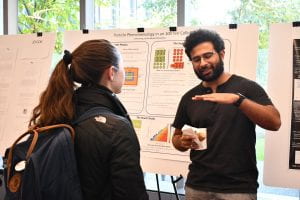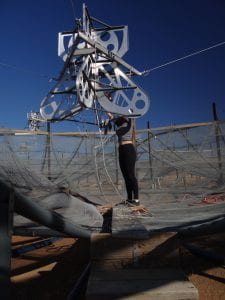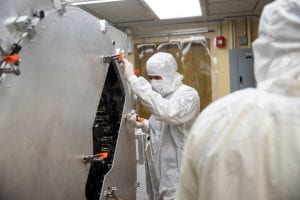Graduate students in the Department of Physics at Brown are heavily involved in research as part of their studies. They work closely with their advisors, and often participate in writing papers based on their collective research. Here are some examples of graduate students who are connected to the CFPU through their advisors, and their experiences doing research at Brown.
Jatan Buch

During my graduate studies I was advised by Prof. JiJi Fan on problems that explored the nature of dark matter using experimental data. These investigations were two-pronged: a) searching for astrophysical signatures of well-motivated particle dark matter models in stellar data reported by the Gaia mission; b) estimating the effect of astrophysical dark matter substructure (such as streams and debris flow) on the sensitivities of next-generation direct detection experiments including LZ, Xenon-nT, and SENSEI.
While at Brown, I also collaborated with exceptional faculty, postdocs, and fellow graduate students on various aspects of research: from substantial discussions regarding a technical concept to informal conversations that made a dreary work day more fun! Moreover, due to the generous travel funding available to Brown graduate students, I could attend several conferences and workshops, which were great opportunities to obtain valuable feedback on my work as well as to engage with the larger physics community.

Daniya Seitova
During my graduate studies at Brown, I joined Jonathan Pober’s research group to work on developing new techniques for studying the Epoch of Reionization (EoR). The best hope to study EoR is the 21cm hyperfine transition line of neutral hydrogen. However, there are enormous observational challenges to detecting the signal. As foregrounds are several orders of magnitude brighter than the 21 cm signal, extreme precision is needed to cleanly separate the two. My project has been using and developing pyuvsim software, which is a comprehensive simulation package for radio interferometers. High precision simulations of the interferometric array can help us calibrate the data and vet new analysis pipelines to see if they meet the required precision. My initial work with pyuvsim was to compare its results with other radio astronomy simulators, which showed unique capabilities of pyuvsim and proved it to be a useful reference for other simulators.
In addition, Brown’s travel funding allowed me to visit HERA, a telescope in South Africa, which gave me an opportunity to have hands-on experience with a real interferometer. I am excited to be working on projects at the frontier of cosmology with cutting edge experiments.

Casey Rhyne
My research experiences at Brown have been closely tied to my contributions to and participation in the LUX and LUX-ZEPLIN dark matter experiments. Early in my grad school career, I got the opportunity to work on-site of the LUX experiment at Sanford Lab in Lead, SD. While I helped in day-to-day shifting operations to keep the detector running during our searches for dark matter, the most salient points for me were helping run the D-D neutron generator calibrations of the detector, which the Brown group pioneered and oversaw, and which helped LUX extend its search for dark matter into a lower mass regime. I used Geant4 physics simulations and discussions with the Brown group to develop a new method for neutron calibration using Brown’s D-D generator alongside a deuterium-based neutron reflector to produce a low energy mono-energetic neutrons, the results of which we published alongside the original D-D generator characterization tests at Brown in this paper.
My research experiences at Brown have been closely tied to my contributions to and participation in the LUX and LUX-ZEPLIN dark matter experiments. Early in my grad school career, I got the opportunity to work on-site of the LUX experiment at Sanford Lab in Lead, SD. While I helped in day-to-day shifting operations to keep the detector running during our searches for dark matter, the most salient points for me were helping run the D-D neutron generator calibrations of the detector, which the Brown group pioneered and oversaw, and which helped LUX extend its search for dark matter into a lower mass regime. I used Geant4 physics simulations and discussions with the Brown group to develop a new method for neutron calibration using Brown’s D-D generator alongside a deuterium-based neutron reflector to produce a low energy mono-energetic neutrons, the results of which we published alongside the original D-D generator characterization tests at Brown in this paper.

Following the end of LUX’s dark matter search, I got the chance to lead a trial calibration campaign in LUX using the principles developed from my simulation work. More recently, I’ve designed an experimental test setup at Brown to characterize and optimize this technique for use in the upcoming LUX-ZEPLIN experiment (design and simulations of which can found here and here) using an active neutron-detecting reflector, and have since built and confirmed the technique’s effectiveness, with a paper on the work upcoming, and a scheduled slot for calibration once LUX-ZEPLIN is fully operational. My work on neutron calibration has personally been a quite scientifically satisfying experience, having started as just an idea, fleshed out and designed, then finally built and tested with the prospect of soon using it to assist in the search for dark matter.
On the opposite side of the coin, Brown’s responsibility in delivering LUX-ZEPLIN’s main photomultiplier tube (PMT) arrays has given me the chance to collaborate with many others and develop my skills managing a team. The PMT arrays (which can be thought of as the “eyes” of a dark matter search experiment capable of detecting singular photons generated within the detector) were constructed here at Brown through a concerted effort from everyone in our group alongside many others in the LUX-ZEPLIN collaboration (with some of our story shown here). I played a large part in organizing the Brown assembly work (as well as contributing to the arrays’ assembly, quality-assurance, and testing myself), and through our day-to-day work confronting and solving issues together as they (inevitably in any experimental work!) came up, I feel that I came out of the experience having grown as a person, become more confident as a leader, and having learned a lot about what it takes to bring these sorts of large projects to fruition. Looking back, now that the arrays have been delivered and installed in the detector at Sanford Lab (with some of the outcome of our efforts here), I am proud to have helped contribute to such a major piece of the dark matter detector puzzle, and am excited to see them in action once the completed detector begins its search!
Brown Particle Astrophysics Group
